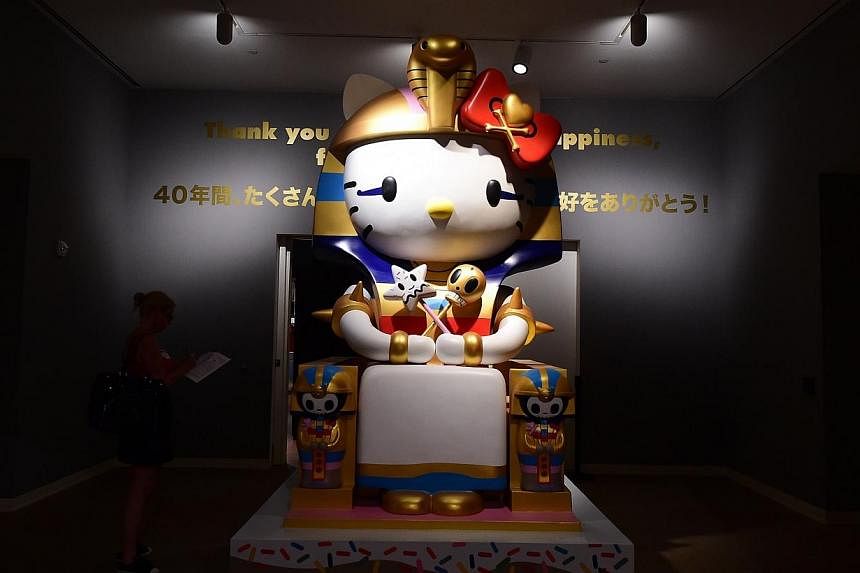If Hello Kitty fans are bothered by the recent kerfuffle over whether or not she is a cat, they gave little indication of it at the world's first Hello Kitty convention, which opened in Los Angeles at The Geffen Contemporary on Thursday.
Instead, they kept calm and shopped on, with hundreds forming orderly queues to get into Day 1 of Hello Kitty Con 2014, a four-day event celebrating the 40th anniversary of one of the most recognised characters on the planet.
Most came for the merchandise. The largely female crowd - which ranged from pre-schoolers to professionals to retirees, many wearing outsized red bows in their hair just like Kitty - huddled around booths selling an array of collectibles, from US$5 (S$6.40) key chains to US$450 make-up brush sets.
For the truly devout, the HK Ink booth offered one of the few mementos that came free of charge: a permanent tattoo. For the less bold, there were lectures on the art, history and cultural impact of the character, and workshops on cookery, nail art and scrapbooking.
Roving bands of cosplayers - dressed up as Kitty and other characters - fuelled rounds of selfies and picture-taking, as did displays of special Hello Kitty fashions and vintage products. Organisers expect more than 25,000 visitors over four days.
But there was the occasional ripple of discontent. Several fans simply could not wrap their heads around the idea that their beloved character - she with the whiskers and the distinctly cat-shaped head - might not be feline.
This troubling detail was highlighted by Sanrio, the Japanese company that created her in 1974, in the run-up to the character's official birthday and anniversary today. For according to her official backstory, Hello Kitty is not a cat, but a little English girl named Kitty White.
Sanrio - which initially just wanted to jazz up its plain stationery products - came up with this to appeal to the Anglophilia of Japanese consumers. And it worked better than they could have imagined, with Hello Kitty now one of most profitable international brands in the world, a merchandising juggernaut worth US$5 billion a year.
Much of that comes from the United States, where Hello Kitty found its first foothold among Asian American communities in the 1970s.
Still, hearing that Kitty is supposed to be a girl has annoyed many aficionados here, including 26-year-old nurse Artressa Ng, a lifelong devotee who never once doubted that Kitty was a cat.
Visibly vexed, she says: "I don't know - I feel like people are just trying to stir up some stuff. I'm like, whatever - I think she's a cat."
Life! asks Ms Janet Hsu, president and chief operating officer of Sanrio's North American arm, to settle it once and for all.
"I know she may look like a cat but she's a girl - that's what her formal bio says."
It gets a little more complicated, though. Other Sanrio executives have explained that Hello Kitty is technically a "gijinka", which is the Japanese word for "anthropomorphisation", or the attribution of human features to non-human things.
"Hello Kitty was done in the motif of a cat. It's going too far to say that Hello Kitty is not a cat. Hello Kitty is a personification of a cat," a spokesman told the Kotaku.com website.
Asked about this, Ms Hsu repeats, firmly, that Kitty is still a girl, noting that she "does not drink milk from a bowl, she doesn't purr and she has a real cat for a pet - Charmmy Kitty".
But she says fans should not get too caught up in such philosophical debates.
"We always say she is what you want her to be. So don't be upset - if you want her to be a cat because she looks like a cat, sure. She's her own definition anyway."
In any case, this fluid identity may be the key to Hello Kitty's enduring appeal, according to those who have studied her success.
University of Hawaii anthropologist Christine Yano - who gave a talk about the global impact of the brand and curated a new Hello Kitty exhibition that will run at the Japanese American National Museum in Los Angeles till April 26 - believes the character's inscrutable features and expressionlessness makes her a blank slate onto which fans can project any emotion.
"There's definitely truth to that," says Ms Hsu. "Because she has a zen-like disposition, it does allow you to project what you want onto her. That's why there's always been a very personal connection between her and each fan. And the fan holds that connection through many years and decades."
Hello Kitty has also stayed popular by staying current - for instance, by tying up with other brands and retailers or launching new products such as the recently announced Hello Kitty Men line.
"Hello Kitty always changes," says Ms Hsu. "To give you an example, today we will be unveiling our Jeffrey Campbell platform shoes - he's such a hot designer right now. We've also unveiled a special edition Beats by Dr Dre headphones, which is another hot product right now.
"So she evolves by integrating herself into pop culture and collaborating with relevant partners. That's why she's had this enduring appeal for 40 years."


